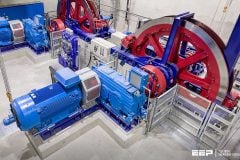Operating Speed Range
The desired speed range may be difficult to achieve depending on the type of application. In general, depending on motor size and load type, very wide ranges may require a special motor.

Operation at very low speeds, requiring the motor to run at very low frequency (below approximately 6 Hz) or very high speeds requiring the motor to run at very high frequencies (above 90 Hz) may require a special motor.
Motor synchronous speed varies directly with the control output frequency. Therefore, the frequency required to achieve a desired application speed can be approximated by dividing the desired speed by the motor rated speed and then multiplying by the rated frequency of the motor.
Examples of speed ranges are listed below, expressed as a ratio of the motor base speed to a minimum speed.
Constant and Variable Torque Speed Range Examples
(Base speed = 2500 RPM)
| Minimum Speed (RPM) | % Motor Base Speed | Speed Range Ratio |
| 1250 | 50 | 2:1 |
| 625 | 25 | 4:1 |
| 250 | 10 | 10:1 |
| 125 | 5 | 20:1 |
| 25 | 1 | 100:1 |
Constant horsepower applications have a speed range where the base speed is the lowest speed not the
top speed.
Constant Horsepower Speed Range Examples
(Base speed = 2500 RPM)
| Minimum Speed (RPM) | % Motor Base Speed | Speed Range Ratio |
| 3750 | 150 | 1.5:1 |
| 5000 | 200 | 2:1 |
| 7500 | 300 | 3:1 |
Note: These speed range examples are for illustration purposes only. Not all motors will be capable of operating withinthese ranges.
Breakaway Torque
The motor must have enough breakaway torque to start the load.
This is not related to the motor locked rotor or starting torque published for across-the-line starting. Breakaway torque is limited by the motor, the available current from the control, and by the setup of the control.
If the static torque required to start the load moving is above 140 percent of motor full-load torque, an oversized control and a motor with sufficient torque capability may be required.
There are several techniques that can be used to achieve the required torque, within the capability of the components used. These techniques should be discussed with the motor manufacturer to achieve the optimum configuration.
Resource: NEMA VSD Guide











please can you my fellow Engineer show me how to calculate setting of thermal overload?
Whenever an Induction motor is running beyond its base speed, then the motor is running in field weakening mode. Then the motor may not deliver the rated torque to that speed. So, for such application one has to check from the motor manufacturer tha how much torque a motor can deliver on that particular speed.